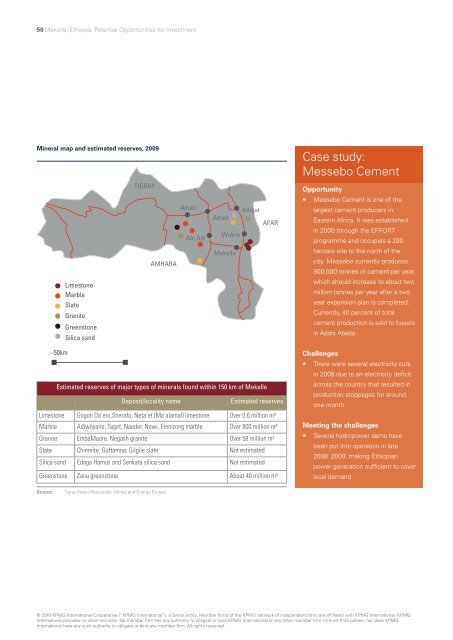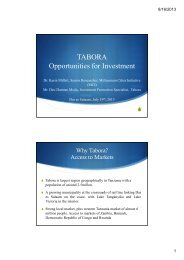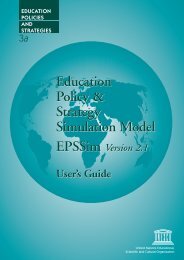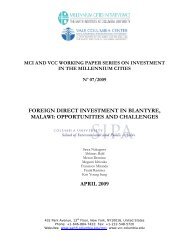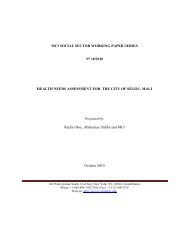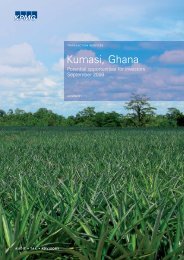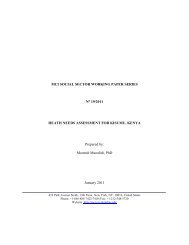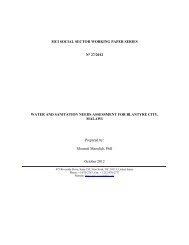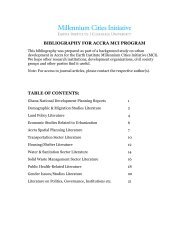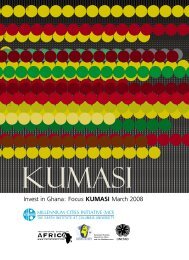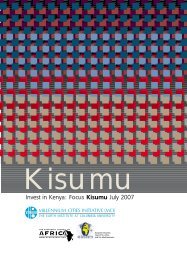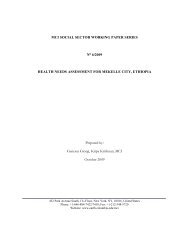Mekelle, Ethiopia - Millennium Cities Initiative - Columbia University
Mekelle, Ethiopia - Millennium Cities Initiative - Columbia University
Mekelle, Ethiopia - Millennium Cities Initiative - Columbia University
You also want an ePaper? Increase the reach of your titles
YUMPU automatically turns print PDFs into web optimized ePapers that Google loves.
50 <strong>Mekelle</strong>, <strong>Ethiopia</strong>: Potential Opportunities for Investment<br />
Mineral map and estimated reserves, 2009<br />
~50km<br />
Limestone<br />
Limestone<br />
Marble<br />
Slate<br />
Granite<br />
Greenstone<br />
Silica sand<br />
TIGRAY<br />
AMHARA<br />
Axum<br />
Abi Adi<br />
Adwa<br />
Wukro<br />
<strong>Mekelle</strong><br />
Adigat<br />
Estimated reserves of major types of minerals found within 150 km of <strong>Mekelle</strong><br />
Deposit/locality name<br />
Gogon Da’ero,Sherafo, Neta’et (Ma’alamal) limestone<br />
AFAR<br />
Estimated reserves<br />
Over 0.6 million m³<br />
Marble Adiwoyane, Taget, Naeder, Newi, Emnizong marble Over 800 million m³<br />
Granite EmbaMadre, Negash granite Over 58 million m³<br />
Slate Chiemite, Guftamne, Gilgile slate Not estimated<br />
Silica sand Edaga Hamus and Senkata silica sand Not estimated<br />
Greenstone Zana greenstone About 40 million m³<br />
Source: Tigray Water Resources, Mines and Energy Bureau<br />
Case study:<br />
Messebo Cement<br />
Opportunity<br />
• Messebo Cement is one of the<br />
largest cement producers in<br />
Eastern Africa. It was established<br />
in 2000 through the EFFORT<br />
programme and occupies a 200<br />
hectare site to the north of the<br />
city. Messebo currently produces<br />
900,000 tonnes of cement per year,<br />
which should increase to about two<br />
million tonnes per year after a two -<br />
year expansion plan is completed.<br />
Currently, 40 percent of total<br />
cement production is sold to buyers<br />
in Addis Ababa.<br />
Challenges<br />
Asab<br />
• There were several electricity cuts<br />
in 2008 due to an electricity deficit<br />
across the country that resulted in<br />
production stoppages for around<br />
one month.<br />
Meeting the challenges<br />
• Several hydropower dams have<br />
been put into operation in late<br />
Somalia<br />
2008 –2009, making <strong>Ethiopia</strong>n<br />
power generation sufficient to cover<br />
local demand.<br />
© 2010 KPMG International Cooperative (“KPMG International”), a Swiss entity. Member firms of the KPMG network of independent firms are affiliated with KPMG International. KPMG<br />
International provides no client services. No member firm has any authority to obligate or bind KPMG International or any other member firm vis-à-vis third parties, nor does KPMG<br />
International have any such authority to obligate or bind any member firm. All rights reserved.


